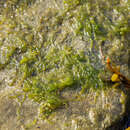Comprehensive Description
provided by Smithsonian Contributions to Botany
Ulva intestinalis Linnaeus
Ulva intestinalis Linnaeus, 1753:1163; Linnaeus, 1755:418; Blomster et al., 1998:332, figs. 49 (typotype), 52–54; Hayden et al., 2003:289, tbl. 4; Hayden and Waaland, 2004:377, tbl. 3; Pedroche et al., 2005:27; Mateo-Cid et al., 2006:48; Pacheco-Ruíz et al., 2008:191, 201.
Enteromorpha intestinalis (Linnaeus) Link in Nees, 1820:Index [2], 5; Howe, 1911:490; Setchell and Gardner, 1920b:252; Dawson, 1944:203; Dawson, 1961b:373; Dawson, 1962c:278; Bliding, 1963:139, figs. 87–89; Dawson, 1966a:5; Huerta-Múzquiz and Tirado-Lizárraga, 1970:126; Brusca and Thomson, 1975:42; Norris, 1976a:76, fig. 31; Huerta-Múzquiz, 1978:336, 338; Silva, 1979:340; L. Aguilar-Rosas et al., 1982:61; R. Aguilar-Rosas, 1982:84; Koeman and van den Hoek, 1982a:308, figs. 70–94; Littler and Arnold, 1982:309; L. Aguilar-Rosas and Bertsch, 1983:114, 119; L. Aguilar-Rosas et al., 1985:125; Huerta-Múzquiz and Mendoza-González, 1985:42; Ibarra-Obando and R. Aguilar-Rosas, 1985:96; L. Aguilar-Rosas and Pacheco-Ruíz, 1986:77; Tello-Velazco, 1986:73; L. Aguilar-Rosas and Pacheco-Ruíz, 1989:81; Sánchez-Rodríguez et al., 1989:39; R. Aguilar-Rosas and Machado-Galindo, 1990:188; Dreckmann et al., 1990:24, 37; Rocha-Ramírez and Siqueiros-Beltrones, 1991:30; González-González, 1993:443; Mateo-Cid et al., 1993:51; Stout and Dreckmann, 1993:4; R. Aguilar-Rosas and M. Aguilar-Rosas, 1994:517, 529; Mendoza-González et al., 1994:112; González-González et al., 1996:285; Mendoza-González and Mateo-Cid, 1996:74, 87, pl. 23: figs. 98–101; Anaya-Reyna and Riosmena-Rodríguez, 1996:862; Pacheco-Ruíz and Zertuche-González, 1996a:432; Leskinen and Pamilo, 1997:17; Bucio-Pacheco and Dreckmann, 1998:42; Yoshida, 1998:35; Mendoza-González and Mateo-Cid, 1998:24, 27; Blomster et al., 1998:319, figs. 1–3, 16–26, 27–29, 49, 52–54; Rodríguez-Morales and Siqueiros-Beltrones, 1999:30; L. Aguilar-Rosas et al., 2000:133; León-Tejera and González-González, 2000:327; Paul-Chávez and Riosmena-Rodríguez, 2000:146; Cruz-Ayala et al., 2001:190; Abbott and Huisman, 2004:49, fig. 7A–C; Riosmena-Rodríguez et al., 2005:101; Hernández-Herrera et al., 2005:146; R. Aguilar-Rosas et al. 2005b:35; Dreckmann et al., 2006:153.
Enteromorpha marchantiae Setchell et N. L. Gardner, 1924a:716, pl. 16: figs. 40–42.
Algae usually simple, tubular and smooth throughout (sometimes irregularly inflated and constricted), up to 15 mm in diameter; attenuated toward base, remaining tubular (rarely becoming slightly compressed) and broadening upward; rarely branched. Cells in surface view, irregularly arranged throughout; 5–10 µm wide and 5–12 (–17) µm long; with a single cup-shaped chloroplast and usually 1(–2) pyrenoid(s).
HABITAT. On rocks, occasionally epiphytic on other algae; high to low intertidal; also dredged 4–50 m (Dawson, 1944).
DISTRIBUTION. Gulf of California: Puerto Peñasco to Bahía La Paz. Pacific coast: Alaska to Chiapas; Peru; Chile; Hawaiian Islands; Japan; China.
TYPE LOCALITY. “In Mari omni” (Linnaeus, 1753); probably Woolwich, River Thames, London, England (based on selection of lectotype illustration of Dillenius [1742:pl. 9: fig. 7] and typotype [see Stearn, 1957:129] by Blomster et al. [1999:332, figs. 49, 52–54]).
- bibliographic citation
- Norris, James N. 2010. "Marine algae of the northern Gulf of California : Chlorophyta and Phaeophyceae." Smithsonian Contributions to Botany. 276-276. https://doi.org/10.5479/si.0081024X.94.276

